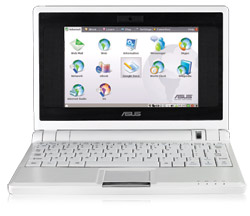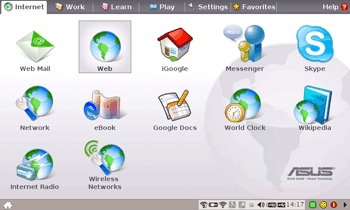Linux-powered Asus Eee PC mini-laptop arrives
Nov 1, 2007 — by LinuxDevices Staff — from the LinuxDevices Archive — 20 views The Xandros Linux-powered “ultra-mobile PC” (UMPC) has finally arrived. One of the most eagerly awaited laptops in some time, the tiny Asus Eee PC 4G, is now available from online retailers that include Newegg and Directon.
The Xandros Linux-powered “ultra-mobile PC” (UMPC) has finally arrived. One of the most eagerly awaited laptops in some time, the tiny Asus Eee PC 4G, is now available from online retailers that include Newegg and Directon.
digg this story |
When the news first broke that Taiwanese computer manufacturer Asus was coming out with a less than two pounds mini-laptop for under $200 that would be running Linux, both gadget and Linux desktop fans were thrilled. Now that it's here, the Eee PC 4G's price has doubled, but early reviewers are still finding this Xandros-Linux powered laptop to be worth the price.

The Eee PC 4G looks like a tiny laptop
It helps, though, to keep in mind that this is not a full-blown laptop. If that's what you want, we recommend you check into Dell's Ubuntu-powered Inspiron 1420 Notebook, or Lenovo's ThinkPad T Series business notebooks with SLED (SUSE Linux Enterprise Desktop) 10 SP 1.
What's the difference? Well, for one thing, instead of an 80GB hard drive, the Eee PC 4G has a 4GB SSD (solid state drive). In place of the 1.5GHz Intel Core 2 Duo T5250 processor that the 1420 comes with, the Asus UMPC uses a 900MHz Intel “Dothan” Celeron M CPU.
It's all a matter of setting expectations. If you want an inexpensive, light-weight system that can handle all the home, work, and Internet basics, the Eee PC 4G may be all you need.
The 7-inch diagonal LCD screen, which is driven by an Intel Graphics Media Accelerator 900 GM chipset, has an 800×480 pixel resolution that's perfectly adequate for most program use. You may, however, find yourself needing to scroll back and forth horizontally to view some Web sites.
Reviewers agree, to no one's surprise, that the keyboard is on the small side. It's about 4/5ths the size of a conventional laptop keyboard. On the other hand, the size reduction has been taken out mostly on the function keys rather than the alphanumeric keys. The result seems to be a keyboard that's a lot more usable than, say, a Blackberry Pearl's, but not the equal of a normal notebook's keyboard.
The scratchpad, in particular, has been singled out as being too small. Fortunately, Asus didn't scrimp on the ports.
The device provides three USB 2.0 ports. I'd suggest plugging a mouse in immediately.
It also has a 100Mbps Ethernet port, a modem, and built-in WiFi (802.11a/g) for your network needs. There's also a VGA port for external monitor hookups.
While the machine doesn't have any kind of optical drive, it does have SD (Secure Digital) and Memory Stick card readers. You can use these for either their typical jobs — importing photographs or video — or what might be even more useful, as secondary storage to the built-in SSD.
KDE desktop
The version of Xandros on the Eee PC 4G uses the KDE environment. The desktop has been customized to make it as easy as possible to use. For instance, the initial screen consists of a set of four tabbed pages: Internet, Work, Learn, and Play. On each page you'll find the appropriate icons for that page's set of applications.
The system's applications include such usual Linux favorites as OpenOffice, Firefox, and Thunderbird. To make life easier still, some pages include links to useful sites such as Google Docs.

An Asus application page ready and waiting for you
Even though this is a lightweight laptop in just about any way you'd take the word, “lightweight,” it does have one heavyweight feature. This is that, thanks to Xandros, it works extremely well with Windows networks. From all reports, and our own experiences with Xandros on other PCs, it's easy to hook the Eee PC 4G to Windows or Samba network drives and printers.
So, is it worth it? From what we can tell, the answer depends mostly on what you want from a laptop. If you're a power-user, or a Linux maven, this isn't a system for you. If, you just want a cheap, light mini-laptop to toss in your luggage and be able to do the basics at home, office, or on the road, it might just be the baby laptop you've been waiting for.
This article was originally published on LinuxDevices.com and has been donated to the open source community by QuinStreet Inc. Please visit LinuxToday.com for up-to-date news and articles about Linux and open source.